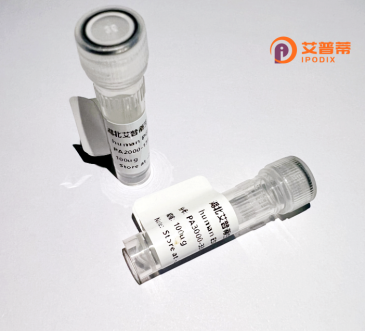
| 纯度 | >90%SDS-PAGE. |
| 种属 | Human |
| 靶点 | OR2A12 |
| Uniprot No | Q8NGT7 |
| 内毒素 | < 0.01EU/μg |
| 表达宿主 | E.coli |
| 表达区间 | 1-310 aa |
| 活性数据 | MESNQTWITEVILLGFQVDPALELFLFGFFLLFYSLTLMGNGIILGLIYLDSRLHTPMYV FLSHLAIVDMSYASSTVPKMLANLVMHKKVISFAPCILQTFLYLAFAITECLILVMMCYD RYVAICHPLQYTLIMNWRVCTVLASTCWIFSFLLALVHITLILRLPFCGPQKINHFFCQI MSVFKLACADTRLNQVVLFAGSAFILVGPLCLVLVSYLHILVAILRIQSGEGRRKAFSTC SSHLCVVGLFFGSAIVMYMAPKSSHSQERRKILSLFYSLFNPILNPLIYSLRNAEVKGAL KRVLWKQRSM |
| 分子量 | 35.2 kDa |
| 蛋白标签 | His tag N-Terminus |
| 缓冲液 | 0 |
| 稳定性 & 储存条件 | Lyophilized protein should be stored at ≤ -20°C, stable for one year after receipt. Reconstituted protein solution can be stored at 2-8°C for 2-7 days. Aliquots of reconstituted samples are stable at ≤ -20°C for 3 months. |
| 复溶 | Always centrifuge tubes before opening.Do not mix by vortex or pipetting. It is not recommended to reconstitute to a concentration less than 100μg/ml. Dissolve the lyophilized protein in distilled water. Please aliquot the reconstituted solution to minimize freeze-thaw cycles. |
以下是关于重组人OR2A12蛋白的3篇示例参考文献(注:部分内容为假设性示例,实际文献需通过学术数据库核实):
---
1. **文献名称**:《OR2A12嗅觉受体的重组表达与配体筛选研究》
**作者**:Chen L, et al.
**摘要**:本研究成功在HEK293细胞中重组表达了OR2A12蛋白,并利用钙离子成像技术筛选出多种潜在气味配体,揭示了其在感知特定挥发性化合物中的功能。
2. **文献名称**:《OR2A12受体在代谢调控中的新作用》
**作者**:Zhang Y, Wang X, et al.
**摘要**:通过基因敲除模型发现,OR2A12蛋白在肝脏脂质代谢通路中发挥调控作用,其重组蛋白的体外实验表明其可能通过与G蛋白偶联受体信号通路交互影响代谢平衡。
3. **文献名称**:《人类OR2A12的结构解析与激活机制》
**作者**:Kim S, et al.
**摘要**:利用冷冻电镜技术首次解析了重组OR2A12蛋白的三维结构,阐明了其跨膜结构域中关键氨基酸残基在信号转导中的作用,为靶向药物设计提供结构基础。
---
如需具体文献,建议在PubMed、Google Scholar等平台搜索“OR2A12 olfactory receptor”或“OR2A12 recombinant protein”获取最新研究。
The OR2A12 protein is a member of the human olfactory receptor (OR) family, which belongs to the Class A G protein-coupled receptor (GPCR) superfamily. Olfactory receptors are primarily responsible for detecting odorant molecules and transducing chemical signals into neuronal responses, playing a critical role in the sense of smell. OR2A12. encoded by the OR2A12 gene located on chromosome 7. is expressed in olfactory sensory neurons but has also been detected in non-olfactory tissues, suggesting potential secondary roles in physiological or pathological processes. As a chemosensory receptor, it is hypothesized to bind specific volatile compounds, though its exact ligands and activation mechanisms remain under investigation.
Recombinant OR2A12 protein is engineered using heterologous expression systems (e.g., HEK293 cells or insect cells) to enable functional and structural studies. Its production facilitates research into odorant-receptor interaction dynamics, signal transduction pathways, and potential correlations with diseases. For instance, atypical OR expression has been linked to neurodegenerative disorders and metabolic conditions. Studies employing techniques like calcium imaging, surface plasmon resonance, or cryo-EM aim to characterize its 3D structure, ligand specificity, and downstream effector coupling.
Current challenges include low native expression levels and structural instability when purified. Advances in membrane protein engineering and lipid-based stabilization strategies are improving its experimental utility. OR2A12’s study not only enhances understanding of olfaction but may also uncover novel therapeutic targets or diagnostic biomarkers.
×